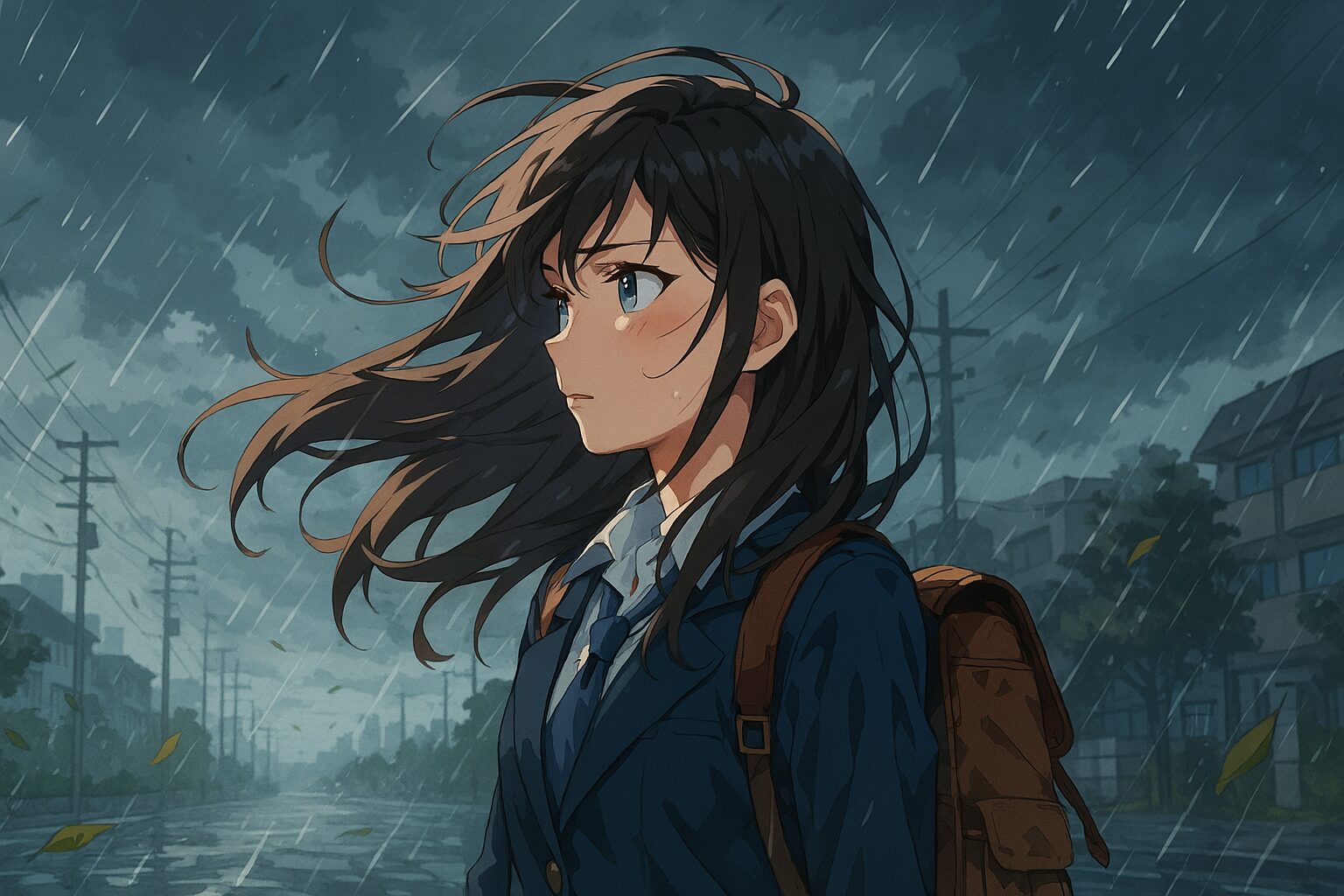Published: September 26, 2025
- Introduction: When the Wind Speaks
- What Is a Typhoon? The Words “Taifū” and “Nowaki”
- Why September 26? Three Historic Typhoons
- Living with Typhoons: Culture Meets Preparedness
- Typhoons and the Economy: Hidden Impacts
- Poetry of the Storm: Haiku and Japanese Sensibility
- Conclusion: Remembering the Wind
- はじめに:風が語る記憶
- 台風とは何か?:日本語の「たいふう」と「野分」
- なぜ9月26日なのか?:歴史に刻まれた3つの台風
- 台風と暮らす日本人:文化と防災の融合
- 台風と経済:見えない影響
- 台風を詠む:俳句と日本語の美
- おわりに:風の記憶を未来へ
Introduction: When the Wind Speaks
September 26 is a special day in Japan known as “Typhoon Day.” For those new to the Japanese language or culture, the word “typhoon” may simply refer to a weather event. But in Japan, typhoons are more than just storms—they are forces of nature that have shaped history, inspired literature, and taught generations how to live with and respect the power of the wind.
What Is a Typhoon? The Words “Taifū” and “Nowaki”
In Japanese, a typhoon is called taifū (台風). But there’s also a poetic word: nowaki (野分), which means “wind that parts the grass.” This term appears in classical literature like The Pillow Book and The Tale of Genji, and is used as a seasonal word in haiku. Typhoons are not only feared—they are also woven into the fabric of Japanese aesthetics and language.
Why September 26? Three Historic Typhoons
Typhoon Day was established because three of the most devastating typhoons in Japanese history struck around this date:
- Toyamaru Typhoon (1954): A ferry sank between Hokkaido and Aomori, killing over 1,000 people.
- Kano River Typhoon (1958): Torrential rain and flooding hit the Izu Peninsula and Tokyo area, with over 1,200 casualties.
- Isewan Typhoon (1959): Japan’s deadliest postwar typhoon, with over 5,000 dead or missing and 570,000 homes damaged.
These events led to September 26 being remembered as a day to reflect on nature’s power and the importance of disaster preparedness.
Reference: BestCalendar.jp|What is Typhoon Day?
Living with Typhoons: Culture Meets Preparedness
Japan experiences typhoons every year, especially from August to September. Over time, the country has developed sophisticated systems to predict, prepare for, and respond to these storms:
- Advanced satellite tracking and weather forecasting
- Community evacuation drills and emergency shelters
- Reinforced riverbanks and urban infrastructure
- Household emergency kits with food, water, flashlights, and radios
For real-time updates and safety information: Japan Meteorological Agency|Typhoon Info
Typhoons and the Economy: Hidden Impacts
Typhoons affect more than just the weather—they disrupt agriculture, fisheries, transportation, tourism, and supply chains. Recovery costs also impact construction and insurance industries, making typhoons a nationwide concern beyond the immediate damage.
Poetry of the Storm: Haiku and Japanese Sensibility
Typhoons are also part of Japan’s poetic tradition. The word “nowaki” is used in seasonal poetry to evoke the emotional aftermath of a storm. One famous line from The Pillow Book reads:
“The day after a typhoon—how deeply moving and beautiful it is.”
— Sei Shōnagon
Even in destruction, Japanese literature finds moments of quiet reflection and beauty.
Conclusion: Remembering the Wind
Typhoon Day is not just a weather-related observance. It’s a day that symbolizes Japan’s relationship with nature, its resilience, and its cultural depth. For international readers, it offers a window into how Japan transforms hardship into wisdom, and how even the wind can carry stories worth remembering.
Learn more:
PR TIMES MAGAZINE|Typhoon Day
Zatsugaku.com|Typhoon Day Trivia
Wikipedia|Isewan Typhoon
台風襲来の日|9月26日に思いを馳せる、日本の自然と記憶
公開日:2025年9月26日
はじめに:風が語る記憶
9月26日――この日は、日本にとって特別な意味を持つ記念日です。その名も「台風襲来の日」。日本語を学び始めたばかりの方や、日本の文化に興味を持つ海外の読者にとって、「台風」という言葉は単なる気象現象かもしれません。しかし、日本では台風は自然の猛威であると同時に、歴史と記憶を刻む存在でもあります。
台風とは何か?:日本語の「たいふう」と「野分」
台風(たいふう)は、北西太平洋で発生する強い熱帯低気圧のこと。英語では「typhoon」と呼ばれますが、日本語では古くから「野分(のわき)」という美しい言葉でも表現されてきました。「野分」とは、野の草を吹き分ける風という意味で、平安時代の文学作品『枕草子』や『源氏物語』にも登場します。
なぜ9月26日なのか?:歴史に刻まれた3つの台風
- 洞爺丸台風(1954年):青函連絡船「洞爺丸」が転覆し、死者・行方不明者は1,000人以上。
- 狩野川台風(1958年):伊豆・関東を中心に豪雨と洪水が発生。死者・行方不明者は1,200人以上。
- 伊勢湾台風(1959年):東海地方を中心に甚大な被害。死者・行方不明者は5,000人以上。
これらの台風がいずれも9月26日前後に襲来したことから、この日が「台風襲来の日」として記念されるようになりました。
参考リンク:BestCalendar.jp|台風襲来の日とは?
台風と暮らす日本人:文化と防災の融合
日本では台風の季節が毎年訪れます。特に8月〜9月は台風の発生・上陸が多く、統計的にも9月26日前後が最も危険な時期とされています。現代では、気象衛星による進路予測、避難所の整備、河川堤防の強化など、さまざまな防災対策が進められています。
防災情報の確認には:気象庁|台風情報
台風と経済:見えない影響
台風は農業・漁業・交通・観光など、さまざまな分野に影響を与えます。特に物流の停滞や建築・保険業界の復旧コストは、地域経済だけでなく全国規模で波及します。
台風を詠む:俳句と日本語の美
台風は「野分」として秋の季語になっており、俳句や短歌に詠まれることもあります。
野分のまたの日こそ、いみじうあはれにをかしけれ
―『枕草子』より
自然の猛威を経て訪れる静けさに、心を寄せる感性が日本文化には根付いています。
おわりに:風の記憶を未来へ
「台風襲来の日」は、自然と共に生きる日本人の知恵と記憶、そして未来への備えを象徴する日です。海外の皆さんにとっては、日本の自然災害への向き合い方や、文化的な受け止め方を知る貴重な機会になるでしょう。
さらに詳しく知りたい方へ:
PR TIMES MAGAZINE|台風襲来の日
雑学.com|台風襲来の日の由来
Wikipedia|伊勢湾台風



コメント